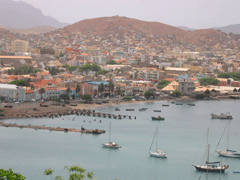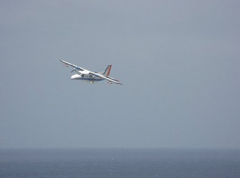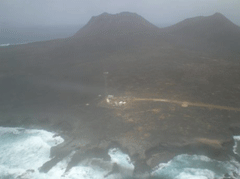Tropical Sinks Gobble Greenhouse Gases
Air Date: Week of July 4, 2008

Sao Vicente (Photo: Bryan Ho)
Sea spray could be doing more than just keeping beachgoers cool this summer. A team of scientists recently discovered that sinks in the tropical Atlantic are eating up greenhouse gases such as ozone at a faster rate than previously predicted. Host Bruce Gellerman speaks with Professor Alastair Lewis of the National Center for Atmospheric Science about this mystery of the missing ozone.
Transcript
GELLERMAN: You’ve heard of a who-done it - this is a what-done it. Last year, a team of scientists on the remote Cape Verdean island of São Vicente noticed something very strange. Large amounts of ozone, almost half as much ozone as climate models predicted should be above the tropical Atlantic Ocean, were missing. To solve the mystery of the missing greenhouse gas, scientists built new instruments loaded them onto airplanes and took to the skies. And what they detected just might help save the planet from global warming. Professor Alastair Lewis is the science sleuth who led the investigation. He’s Director of Atmospheric Composition at the National Center for Atmospheric Science in York, England. Welcome to Living on Earth Professor Lewis!
LEWIS: My pleasure. Great to talk about these things on a science show.
GELLERMAN: So where did the ozone go?
LEWIS: Okay, so ozone is destroyed when it’s hit by sunlight and the things that you need to destroy ozone efficiently is lots of sunlight and so it’s no big surprise that the tropics are gonna be the place where we’re gonna get the highest lost. What’s surprising here is that we found more loss than you would explain just by sunlight hitting the molecule on its own. And in fact what we found was some extra chemicals that speed up this process and add on top of it and this was the big surprise. And in fact these processes involve some rather unusual chemicals involving bromine and iodine.

Sao Vicente (Photo: Bryan Ho)
LEWIS: They sort of come from the same place but not the same source if you take what I mean. So you have bromine which we believe comes from small microscopic particles in the air that are generated over the oceans by waves breaking. The iodine compounds well it’s a bit more uncertain. We think they probably come from small microscopic biological entities in the ocean but again we’re a bit less certain. But they come from the ocean anyway.
GELLERMAN: So these two chemicals they interact with the ozone and somehow they turn it into something which is not a greenhouse gas?
LEWIS: That’s right they destroy the ozone and turn it into something that isn’t a greenhouse gas. And part of this process—it’s a very complicated set of reactions, it’s not a single easily described step—but one of the outcomes is actually you also begin to destroy a little bit extra of the greenhouse gas methane as well.
GELLERMAN: So these two chemicals in this particular part of the Atlantic Ocean are released. Why this particular part?

The NERC 228 Dornier research aircraft taking measurements over the ocean close to the Observatory.
LEWIS: Well this is why the discovery is quite important. We don’t think there’s actually anything specific and unique to this bit of the ocean. Our hypothesis is actually this is very typical open ocean for the tropics; there’s nothing unusual here. So if we see these chemicals released and the ozone disappearing in these places because of this it could well be happening all over the tropical Atlantic, all over the tropical Pacific as well. So we think our findings may scale up to cover large chunks of the planet.
GELLERMAN: Well this is really good news.
LEWIS: The sort of the glass half full view of course is that this is good, this means that if we get to grips with reducing our methane emissions the atmosphere will clean itself up quicker than we thought—this is good. If you take the glass half empty view, it’s well, we did a pretty good job of predicting methane so perhaps it means there are additional sources that we haven’t taken account of. But we view this generally as a positive thing. If you get to grips with reducing your emissions, the atmosphere will do its bit slightly quicker, clean us up, and give us a sort of quicker win in terms of reducing greenhouse gases.

The Atmospheric Observatory at the Cape Verde Islands. (Courtesy of Dr. Katie Read, University of York)
LEWIS: Well it certainly shows that we need to keep an open mind, that actually there are some things out there in remote places that are pretty important, that we actually haven’t discovered or accounted for yet, that it’s not a completely done deal in terms of the chemistry of the atmosphere, that there are still some discoveries to come. Understanding how the climate works is still subject to big uncertainties so there are big processes that perhaps we haven’t discovered, or processes that we don’t understand accurately and we need to go to these places to really try all of it and really nail them down and actually determine how fast they’re happening.
GELLERMAN: Boy science is deliciously complex and surprising.

The observatory. (Courtesy of Dr. James McQuaid, National Centre for Atmospheric Science)
GELLERMAN: Why did you decide to set up your equipment and your laboratory in Sao Vicente of all places? I mean that’s way out there.
LEWIS: Well this is I’d love to say it was all science but it isn’t all driven by science this. Partly we had to wait until we could make the instruments that would do the job for us, that would actually measure year round. And part of it was finding somewhere that you could actually get to and do these experiments relatively easily. And one thing that’s happened in Cape Verde recently, certainly over the past five years, is that it’s become a very popular holiday destination. So what this opened up for us was the potential to fly there, set up instruments, move freight around, in a way that perhaps we wouldn’t have been able to do perhaps ten or fifteen years before. So it’s these sort of combination of partly science and partly serendipity that means that we’ve chosen this as our location.
GELLERMAN: Boy, not bad work if you can get it.
LEWIS: Well it’s nice to go to a place with a decent beach.
GELLERMAN: Professor Alastair Lewis is Director of Atmospheric Composition at the National Center for Atmospheric Science in York, UK.
Living on Earth wants to hear from you!
Living on Earth
62 Calef Highway, Suite 212
Lee, NH 03861
Telephone: 617-287-4121
E-mail: comments@loe.org
Newsletter [Click here]
Donate to Living on Earth!
Living on Earth is an independent media program and relies entirely on contributions from listeners and institutions supporting public service. Please donate now to preserve an independent environmental voice.
Newsletter
Living on Earth offers a weekly delivery of the show's rundown to your mailbox. Sign up for our newsletter today!
 Sailors For The Sea: Be the change you want to sea.
Sailors For The Sea: Be the change you want to sea.
 The Grantham Foundation for the Protection of the Environment: Committed to protecting and improving the health of the global environment.
The Grantham Foundation for the Protection of the Environment: Committed to protecting and improving the health of the global environment.
 Contribute to Living on Earth and receive, as our gift to you, an archival print of one of Mark Seth Lender's extraordinary wildlife photographs. Follow the link to see Mark's current collection of photographs.
Contribute to Living on Earth and receive, as our gift to you, an archival print of one of Mark Seth Lender's extraordinary wildlife photographs. Follow the link to see Mark's current collection of photographs.
 Buy a signed copy of Mark Seth Lender's book Smeagull the Seagull & support Living on Earth
Buy a signed copy of Mark Seth Lender's book Smeagull the Seagull & support Living on Earth

